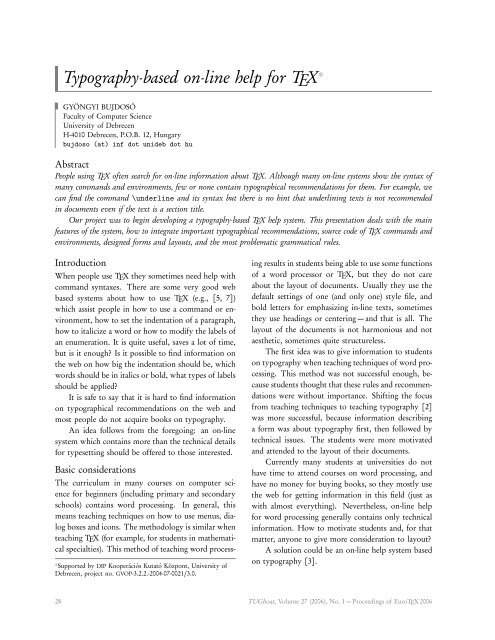The Communications of the TEX Users Group Volume 27 ... - TUG
The Communications of the TEX Users Group Volume 27 ... - TUG
The Communications of the TEX Users Group Volume 27 ... - TUG
You also want an ePaper? Increase the reach of your titles
YUMPU automatically turns print PDFs into web optimized ePapers that Google loves.
Typography-based on-line help for <strong>TEX</strong> ∗<br />
GYÖNGYI BUJDOSÓ<br />
Faculty <strong>of</strong> Computer Science<br />
University <strong>of</strong> Debrecen<br />
H-4010 Debrecen, P.O.B. 12, Hungary<br />
bujdoso (at) inf dot unideb dot hu<br />
Abstract<br />
People using <strong>TEX</strong> <strong>of</strong>ten search for on-line information about <strong>TEX</strong>. Although many on-line systems show <strong>the</strong> syntax <strong>of</strong><br />
many commands and environments, few or none contain typographical recommendations for <strong>the</strong>m. For example, we<br />
can find <strong>the</strong> command \underline and its syntax but <strong>the</strong>re is no hint that underlining texts is not recommended<br />
in documents even if <strong>the</strong> text is a section title.<br />
Our project was to begin developing a typography-based <strong>TEX</strong> help system. This presentation deals with <strong>the</strong> main<br />
features <strong>of</strong> <strong>the</strong> system, how to integrate important typographical recommendations, source code <strong>of</strong> <strong>TEX</strong> commands and<br />
environments, designed forms and layouts, and <strong>the</strong> most problematic grammatical rules.<br />
Introduction<br />
When people use <strong>TEX</strong> <strong>the</strong>y sometimes need help with<br />
command syntaxes. <strong>The</strong>re are some very good web<br />
based systems about how to use <strong>TEX</strong> (e.g., [5, 7])<br />
which assist people in how to use a command or environment,<br />
how to set <strong>the</strong> indentation <strong>of</strong> a paragraph,<br />
how to italicize a word or how to modify <strong>the</strong> labels <strong>of</strong><br />
an enumeration. It is quite useful, saves a lot <strong>of</strong> time,<br />
but is it enough? Is it possible to find information on<br />
<strong>the</strong> web on how big <strong>the</strong> indentation should be, which<br />
words should be in italics or bold, what types <strong>of</strong> labels<br />
should be applied?<br />
It is safe to say that it is hard to find information<br />
on typographical recommendations on <strong>the</strong> web and<br />
most people do not acquire books on typography.<br />
An idea follows from <strong>the</strong> foregoing: an on-line<br />
system which contains more than <strong>the</strong> technical details<br />
for typesetting should be <strong>of</strong>fered to those interested.<br />
Basic considerations<br />
<strong>The</strong> curriculum in many courses on computer science<br />
for beginners (including primary and secondary<br />
schools) contains word processing. In general, this<br />
means teaching techniques on how to use menus, dialog<br />
boxes and icons. <strong>The</strong> methodology is similar when<br />
teaching <strong>TEX</strong> (for example, for students in ma<strong>the</strong>matical<br />
specialties). This method <strong>of</strong> teaching word process-<br />
∗ Supported by DIP Kooperációs Kutató Központ, University <strong>of</strong><br />
Debrecen, project no. GVOP-3.2.2.-2004-07-0021/3.0.<br />
ing results in students being able to use some functions<br />
<strong>of</strong> a word processor or <strong>TEX</strong>, but <strong>the</strong>y do not care<br />
about <strong>the</strong> layout <strong>of</strong> documents. Usually <strong>the</strong>y use <strong>the</strong><br />
default settings <strong>of</strong> one (and only one) style file, and<br />
bold letters for emphasizing in-line texts, sometimes<br />
<strong>the</strong>y use headings or centering — and that is all. <strong>The</strong><br />
layout <strong>of</strong> <strong>the</strong> documents is not harmonious and not<br />
aes<strong>the</strong>tic, sometimes quite structureless.<br />
<strong>The</strong> first idea was to give information to students<br />
on typography when teaching techniques <strong>of</strong> word processing.<br />
This method was not successful enough, because<br />
students thought that <strong>the</strong>se rules and recommendations<br />
were without importance. Shifting <strong>the</strong> focus<br />
from teaching techniques to teaching typography[2]<br />
was more successful, because information describing<br />
a form was about typography first, <strong>the</strong>n followed by<br />
technical issues. <strong>The</strong> students were more motivated<br />
and attended to <strong>the</strong> layout <strong>of</strong> <strong>the</strong>ir documents.<br />
Currently many students at universities do not<br />
have time to attend courses on word processing, and<br />
have no money for buying books, so <strong>the</strong>y mostly use<br />
<strong>the</strong> web for getting information in this field (just as<br />
with almost everything). Never<strong>the</strong>less, on-line help<br />
for word processing generally contains only technical<br />
information. How to motivate students and, for that<br />
matter, anyone to give more consideration to layout?<br />
A solution could be an on-line help system based<br />
on typography[3].<br />
28 <strong>TUG</strong>boat, <strong>Volume</strong> <strong>27</strong> (2006), No. 1 — Proceedings <strong>of</strong> Euro<strong>TEX</strong> 2006

















